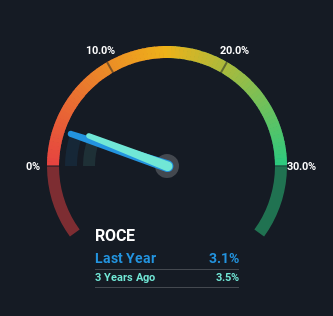- India
- /
- Construction
- /
- NSEI:AKASH
Akash Infra-Projects' (NSE:AKASH) Returns On Capital Tell Us There Is Reason To Feel Uneasy
What financial metrics can indicate to us that a company is maturing or even in decline? When we see a declining return on capital employed (ROCE) in conjunction with a declining base of capital employed, that's often how a mature business shows signs of aging. Ultimately this means that the company is earning less per dollar invested and on top of that, it's shrinking its base of capital employed. Having said that, after a brief look, Akash Infra-Projects (NSE:AKASH) we aren't filled with optimism, but let's investigate further.
What Is Return On Capital Employed (ROCE)?
If you haven't worked with ROCE before, it measures the 'return' (pre-tax profit) a company generates from capital employed in its business. To calculate this metric for Akash Infra-Projects, this is the formula:
Return on Capital Employed = Earnings Before Interest and Tax (EBIT) ÷ (Total Assets - Current Liabilities)
0.031 = ₹30m ÷ (₹1.9b - ₹940m) (Based on the trailing twelve months to June 2023).
Therefore, Akash Infra-Projects has an ROCE of 3.1%. Ultimately, that's a low return and it under-performs the Construction industry average of 13%.
Check out our latest analysis for Akash Infra-Projects

While the past is not representative of the future, it can be helpful to know how a company has performed historically, which is why we have this chart above. If you want to delve into the historical earnings, revenue and cash flow of Akash Infra-Projects, check out these free graphs here.
So How Is Akash Infra-Projects' ROCE Trending?
We are a bit worried about the trend of returns on capital at Akash Infra-Projects. To be more specific, the ROCE was 5.4% five years ago, but since then it has dropped noticeably. On top of that, it's worth noting that the amount of capital employed within the business has remained relatively steady. Since returns are falling and the business has the same amount of assets employed, this can suggest it's a mature business that hasn't had much growth in the last five years. So because these trends aren't typically conducive to creating a multi-bagger, we wouldn't hold our breath on Akash Infra-Projects becoming one if things continue as they have.
On a side note, Akash Infra-Projects' current liabilities have increased over the last five years to 49% of total assets, effectively distorting the ROCE to some degree. If current liabilities hadn't increased as much as they did, the ROCE could actually be even lower. What this means is that in reality, a rather large portion of the business is being funded by the likes of the company's suppliers or short-term creditors, which can bring some risks of its own.
Our Take On Akash Infra-Projects' ROCE
All in all, the lower returns from the same amount of capital employed aren't exactly signs of a compounding machine. Long term shareholders who've owned the stock over the last five years have experienced a 26% depreciation in their investment, so it appears the market might not like these trends either. Unless there is a shift to a more positive trajectory in these metrics, we would look elsewhere.
Akash Infra-Projects does come with some risks though, we found 3 warning signs in our investment analysis, and 2 of those don't sit too well with us...
If you want to search for solid companies with great earnings, check out this free list of companies with good balance sheets and impressive returns on equity.
New: Manage All Your Stock Portfolios in One Place
We've created the ultimate portfolio companion for stock investors, and it's free.
• Connect an unlimited number of Portfolios and see your total in one currency
• Be alerted to new Warning Signs or Risks via email or mobile
• Track the Fair Value of your stocks
Have feedback on this article? Concerned about the content? Get in touch with us directly. Alternatively, email editorial-team (at) simplywallst.com.
This article by Simply Wall St is general in nature. We provide commentary based on historical data and analyst forecasts only using an unbiased methodology and our articles are not intended to be financial advice. It does not constitute a recommendation to buy or sell any stock, and does not take account of your objectives, or your financial situation. We aim to bring you long-term focused analysis driven by fundamental data. Note that our analysis may not factor in the latest price-sensitive company announcements or qualitative material. Simply Wall St has no position in any stocks mentioned.
About NSEI:AKASH
Akash Infra-Projects
Engages in the civil construction business in India.
Acceptable track record with low risk.
Similar Companies
Market Insights
Community Narratives



